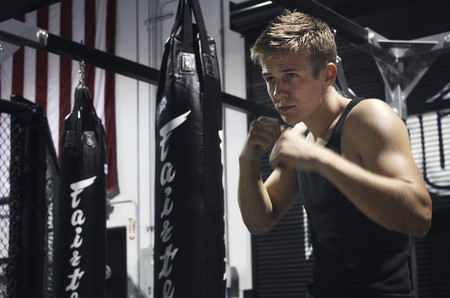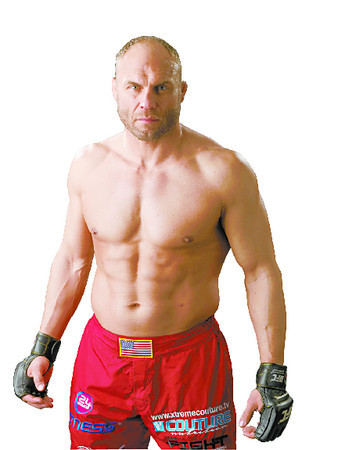LEARNING TO FIGHT: Mixing it up
Growing up, many kids dream of becoming firefighters or police officers. Others see themselves flying into space, rocking out onstage or teaching children how to read. But for some, becoming a professional mixed martial arts fighter is the ultimate job.
Green Valley High School 2009 graduate Ian Niechaj found interest in the sport during his early high school years and says he would love to pursue a career as a professional fighter.
"I first became interested in MMA about two years ago when I saw my first UFC fight," Niechaj said. "I love everything about UFC. It's one of my dreams to become a professional fighter and to compete in the UFC."
Niechaj defines MMA as being a mixture of different fighting techniques, including boxing, kickboxing, muay Thai and jiu-jitsu.
Professional UFC fighter Randy "The Natural" Couture, who had his first professional UFC fight about 13 years ago, agrees with Niechaj's definition of the sport and describes UFC as being a production of it.
"MMA is the combination of different fighting styles, from kickboxing to jiu-jitsu to grappling and other forms of fighting," Couture said. "UFC is basically a production of MMA which, along with several other productions that are on smaller scales, puts on shows and has fighters compete against each other."
MMA is an appealing sport to both men and women. During tournaments, men participate in separate divisions from women so that it is a fair competition for both sexes, according to Niechaj, who fights out of the Tapout Las Vegas training center.
"There are plenty of girls who train at my gym, from 8-year-old girls to 30-year-old women," Niechaj said. "We all train together, but they fight in separate divisions. It's funny because I get beat up by girls every day."
Couture admires the flexibility of the sport. He says it is nice because anyone can participate in MMA, regardless of their body type.
"One of the cool things about this sport is that it's a weight-class sport, so there's about five or six different weight classes," Couture said. "You can make any body type or style effective. You can be long and skinny or short and stocky, it doesn't really matter. People can learn different fighting styles based on the gifts they have been given."
Silverado High School junior Robert Herrera, who trains every day for about four hours, found interest in the sport just more than a year ago after experiencing it firsthand with Niechaj.
"Ian basically got me into it. We would hang out, and he would practice his moves on me, and then I would just start going to train with him," Herrera said.
While Herrera is unsure of whether he wants to become a professional fighter, he said he would be interested in teaching the sport to others.
"I thought about going pro, but I've never been too interested in it," Herrera said. "I would want to teach it, though. I would rather teach the sport than actually do it."
For Niechaj, balancing time is a "little bit tricky," since he works, goes to college and trains almost every other day at his gym.
"I train at the gym Mondays, Wednesdays, Fridays and Saturdays," he said. "It's easier for me to balance my time with the Google calendar. I put everything I have to do on it, and it helps me straighten out my schedule between work, college and training."
Because Herrera also is constantly training, he said he sometimes has to bring his homework with him to the gym and do it there.
Couture recommends that students remain focused primarily on school, but for amateur fighters who are serious about going pro, he said they should focus on one specific fighting style at a time before moving on to amateur MMA fights.
"It takes some time to go pro. I would recommend breaking down the sport into its parts and competing in some of those parts," Couture said. "For example, you can compete in grappling tournaments or kickboxing tournaments first and then get into some amateur MMA fights, which combine those different types of fighting."
According to Couture, it is not necessary to have a personal trainer in order to become a professional fighter, but for Niechaj, having one is extremely helpful in tackling the sports' various components.
"Trainers teach you the technique of a certain style," Niechaj said. "Without technique, you won't really know what you are doing."
Amateurs also should consider training at a gym with other martial artists, Couture said. He said this is a necessity for people who are looking to become advanced fighters.
"I recommend people who are interested in training for MMA to train at a gym because it's a training environment where there are other fighters and trainers who can help to guide them and to help them see where they are at," Couture said. "They can measure the improvement of their skills based upon the status of the other fighters at that gym."
Couture, who took up boxing as a form of exercise during his six years serving in the U.S. Army, said that although the sport is intense, it teaches techniques that are important to know, and he encourages people to learn the sport, even if they are not interested in going pro.
"Doing mixed martial arts is a form of fitness. It doesn't necessarily have to involve competitions or fighting, but the training itself is definitely a lifestyle," Couture said. "It is very physically demanding, but it is something that is good for a person to know because hopefully they won't get into an altercation, but if they need to, they have knowledge of self-defense."
Niechaj agreed that more people should practice MMA, even as just a hobby.
"I definitely recommend other people to do this sport because there's a good workout involved in it," Niechaj said. "Even if I didn't want to go pro, I would still do it because it is really fun, and it helps me to relieve my stress. Plus, everyone I hang out with at my gym is like a family. We are all closely connected."
According to Couture, the best way to figure out if the sport is what you really want to do is to jump right in and experience it firsthand.
"First, get into a good training environment. You should be able to walk into a place and feel good and not intimidated, and you should be able to go there to train and to feel like you're learning and progressing," Couture said. "From there, you'll be on the right path in figuring out whether or not it's the right profession for you."
R-Jeneration


























